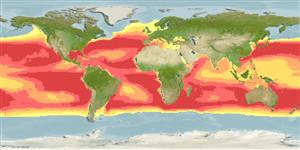Classificação / Names
Common names from other countries
Referência principal
Tamanho / Peso / Idade
Max length : 455 cm FL macho/indeterminado; (Ref. 40637); common length : 300 cm TL macho/indeterminado; (Ref. 9354); Peso máx. publicado: 650.0 kg (Ref. 4689)
Length at first maturity
Lm 221.0, range 156 - 250 cm
Ambiente
; marinhas; oceanódromo (Ref. 51243); intervalo de profundidade 0 - 800 m (Ref. 9354), usually 0 - 550 m (Ref. 54934)
Clima / Intervalo
Temperate; 5°C - 27°C (Ref. 43), preferred 27°C (Ref. 107945); 61°N - 50°S, 180°W - 180°E (Ref. 54934)
Distribuição
Atlantic, Indian and Pacific: tropical and temperate and sometimes cold waters, including the Mediterranean Sea, the Sea of Marmara, the Black Sea, and the Sea of Azov. Highly migratory species, Annex I of the 1982 Convention on the Law of the Sea (Ref. 26139). Mt DNA restriction analysis reveal that genetic differentiation occurs between populations inhabiting the Mediterranean Sea and the tropical Atlantic ocean, indicating little genetic exchange occurring between the two (Ref. 12784).
Países | Áreas FAO | Ecossistemas | Ocorrências | Introduções
Descrição breve
Espinhos dorsais (total): 0; Raios dorsais moles (total): 38-56; Espinhos anais 0; Raios anais moles: 16 - 18. Blackish-brown fading to light-brown below; 1st dorsal fin with blackish-brown membrane, other fins brown or blackish-brown (Ref. 43). A long, flat, sword-like bill and no pelvic fins (Ref. 26938).
Categoria na Lista Vermelha da IUCN (Ref. 115185)
Utilização humana
Pescarias: espécies comerciais; peixe desportivo: sim
Ferramentas
Relatórios especiais
Descarregue XML
Fontes da internet
Estimates of some properties based on models
Phylogenetic diversity index
PD50 = 1.5000 many relatives (e.g. carps) 0.5 - 2.0 few relatives (e.g. lungfishes)
Nível Trófico
4.5 ±0.2 se; Based on diet studies.
Resiliência
Médio, tempo mínimo de duplicação da população 1,4 - 4,4 anos (rm=0.076; K=0.23; tm=5-6; tmax=9)
Vulnerabilidade
High to very high vulnerability (72 of 100)
Categoria de preço
